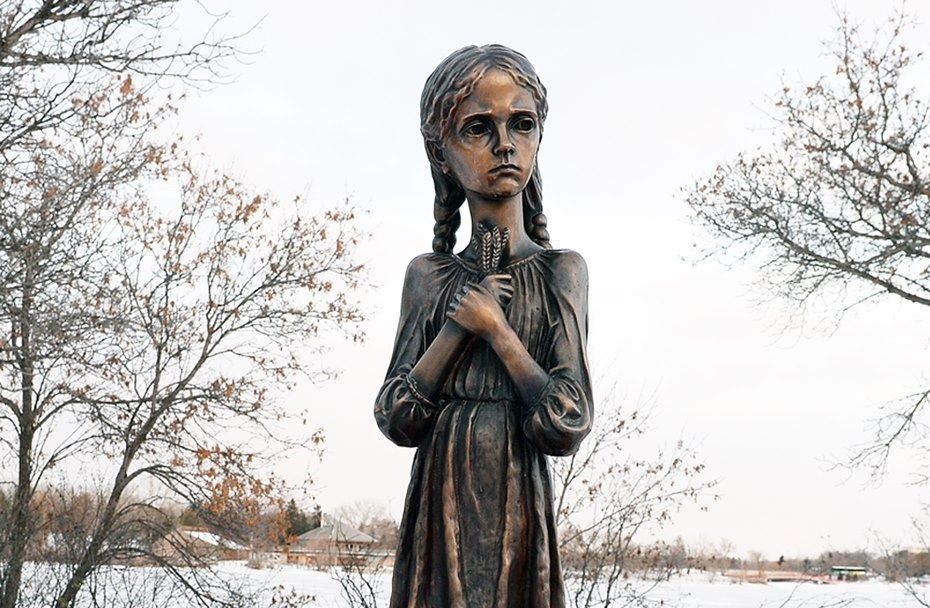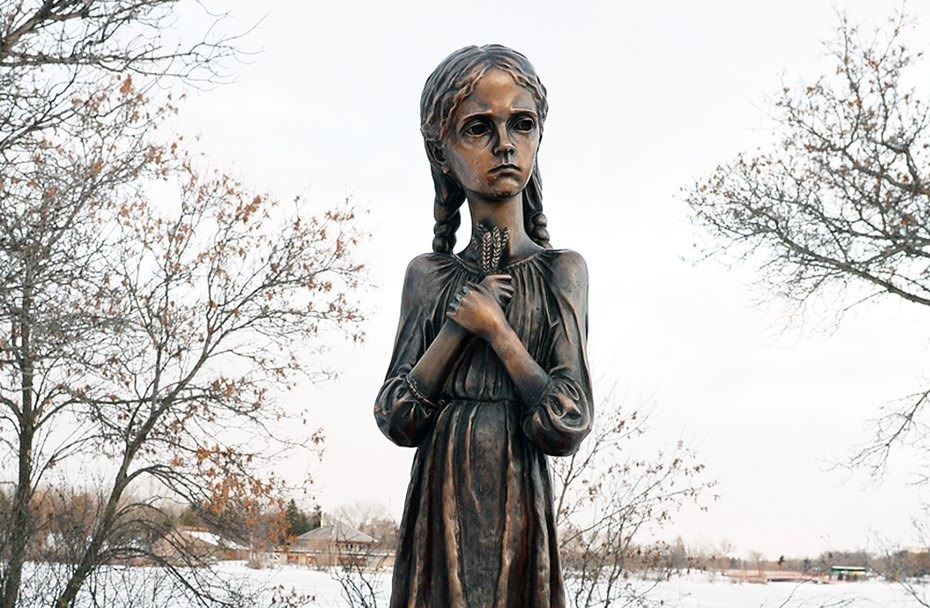Shadow of Holodomor — Ukraine’s killing fields

I was going to put a line about the Holodomor into a different article I was writing about Ukraine... but it didn't deserve a line without two lines. And it didn't deserve two lines—it deserves its own piece. And that leads me to share the story of the Holodomor, which will find more attention now that the world is fascinated with all-things Ukraine.
Holodomor means, “to kill by starvation” placing an emphasis on the fact it was man-made. It is also known as the Terror-Famine. It happened in Ukraine in 1932/33 under Joseph Stalin. It was to become genocide before the term was coined in 1944. Might its shadow be happening in 2022 under Vladimir Putin?

Ukraine means “the border.” Many people still call the country “The Ukraine'' implying “the borderline.” At the beginning of the last century, after the Russian Revolution and the First World War, Ukraine became one of the 15 republics that made up the Union of Soviet Socialist Republics (USSR or Soviet Union). After Vladimir Lenin’s death in 1922, Stalin came to power and ruled until his own death in 1953. He combined the then current Marxist theory with Lenin’s ideology into what would become Stalinism, or his interpretation of how far Marxism-Leninism ought to be represented.
The Soviet leader chartered a new and brutal tangent and singled out Ukraine for one of the most contemptible and vile acts of his lengthy criminal career as a psychotic despot. Stalin created and manipulated a famine in Ukraine.
Ukraine’s soil, particularly the east near the Donbas Region, is some of the most fertile land in the entire world. Wheat production from its “black earth” is why Ukraine was called “the breadbasket of the Soviet Union.” And it still is one of the largest and finest grain producing areas today, minus the shell casings, land mines, and unexploded missiles.
Starting in 1932 a nation-wide, man-made famine occurred in Ukraine, and Stalin declined the offers of international aid, preferring to not address the famine issues he’d intentionally created. Stalin, due to earlier history where Ukraine was briefly independent, did not want Ukraine to fall into the hands of Europe. Under the guise of collectivization, he took all the grain produced in Ukraine and spread it around the rest of the USSR but mostly it went to feed his military.
Local rations in Ukrainian villages were cut back then entirely suspended. Ukrainians had no food at all. Farmers were not allowed to keep even a grain from their harvest. The resulting starvation was called the Holodomor. Uncountable Ukrainians were dispersed to other countries or displaced within their own. Stalin used these methods as a stick to beat the Ukrainians into submission, to be loyal to the Soviet Empire and lose all hope in joining Europe.
The artificial famine was genocidal. That definition of genocide being an internationally recognized crime where acts are committed with the intent to destroy, in whole or in part, a national, ethnic, racial, or religious group. Stalin targeted Ukrainian nationals.
In a period when stealing an apple could get oneself ten years in a Soviet work camp (gulag), no one was left with any food. It’s been said perhaps a thousand people per hour died. That is roughly 17 people per minute, meaning an average 24,000 died per day in the streets, on farms, on factory floors. In all it is estimated nearly 4,000,000 people died, about 13 percent of the population. (The Holodomor was so bad that people resorted to killing and eating pets and flowers, leaves, tree bark and ultimately cannibalism, with over 2500 people being charged for the offense.)
The killing fields of Ukraine were farms in the countryside, backyards in the city, shallow graves outside towns. There is little paperwork on the 1932-1933 famine because Stalin had everything, including the national census, manipulated, or destroyed to hide the truth.
"One death is a tragedy. A million deaths is a statistic." - Joseph Stalin
Stalin, it must be said, at some point in his residency in the Politburo, did cross the threshold of sanity. He was not just evil; he was earnest sociopath, psychotic enough to kill off best friends, his closest staff, and advisors whom he thought were planning to kill him. He had three bedrooms with doors in between so his guards never knew which bedroom he was sleeping in. Suffice to say he was crazily preoccupied about his safety, security, and potential death. He brought the same craziness to preservation of the Soviet Union. Stalin wasn't a great leader; I think his psychosis just found itself in that position of power. If Stalin was a baker, he'd probably have baked 10,000 loaves of stale bread a day, that kind of crazy. He wasn't good at being a leader, but he was the leader.
Is this sufficient context to presage concerns of another Holodomor for Ukraine, intended or otherwise? It does appear Vladimir Putin may be deploying tactics that have precedent components from Stalin’s Holodomor, or at least it may be a leading example. Pray this is a wrong speculation. Yet Russia’s invading forces are systematically depleting or removing Ukraine’s food sources by shelling stores, bombing factories, targeting food supply lines, deterring humanitarian relief aid, and often making farmer’s fields and town gardens unusable. It has been reported that many Ukrainians may starve to death.
There are further similarities between 2022 and 1932. By the mid-1930s futile attempts for Ukraine to be independent and join Europe were dead. The country would not see itself as a sovereign nation until 1991 when the Soviet Union collapsed. In 1994 the Budapest Memorandum was drawn up to protect Ukraine’s borders. The memorandum specifically prohibited the Russian Federation from threatening or using military force or economic coercion against Ukraine, "except in self-defense or otherwise in accordance with the Charter of the United Nations.” The leaders of Russia, Belarus, Kazakhstan, and Ukraine signed the document. As part of this agreement, Ukraine gave up its nuclear arsenal to Russia.
On February 24th, 2022, President Putin went against the Budapest Memorandum and invaded Ukraine.
On March 23 2022 - "The only interpretation is that [the Russians] want to create hunger and to use this method as a method of aggression," the EU's agriculture commissioner, Janusz Wojciechowski, said. "It is similar method that was used in 1930s by Soviet regime against Ukrainian people.”
On March 31, 2022, according to a CNN report, Iryna Vereshchuk, named as the Ukrainian minister responsible for reintegration of temporarily occupied territories, claimed twelve buses full of humanitarian aid went to the endangered city of Mariupol that day, but Russian forces confiscated the 14 tons of food and medications aboard.
April 3, 2022 - According to the Ukrainian government, the amount of land that will be planted this spring could be slashed by more than half, from 15 million hectares to around 6 million. Politico warns of the third month of war as, April is typically when Ukraine's supremely productive farmers start sowing seeds that they will harvest in the summer. But their chances of a successful spring reaping season are critically hampered by shortages of key agricultural materials from fuel and fertilizers to seeds and also a shortage of workers, since huge numbers of male farmers have joined the army.
Marking genocide is never as straightforward as its victims would hope, and yet 28 countries including Australia, Poland, Canada, and Lithuania joined with Ukraine to designate the Holodomor an Act of Genocide, and to establish a national Ukrainian Famine and Genocide (Holodomor) Memorial Day.
Let us sincerely hope that in 2022 we are not witnessing an early unfolding of what could earn the moniker Holodomor 2.0
Sources:
https://www.ushmm.org/genocide-prevention/learn-about-genocide-and-other-mass-atrocities/what-is-genocide
https://en.wikipedia.org/wiki/Holodomor
https://en.wikipedia.org/wiki/Joseph_Stalin
https://en.wikipedia.org/wiki/Stalinism
https://en.wikipedia.org/wiki/History_of_Ukraine
http://sasktoday.ca
https://www.intellinews.com/little-girl-holodomor-statue-in-kyiv
OF RUSSIA: A Year Inside
Brent (Brant is the Russian version) Antonson has seen a Russia few foreigners have. Indeed, few Russians. This young Canadian ventured to Voronezh, eleven hours south of Moscow by train, to spend a year inside a country torn by strife, fresh into a new century, and struggling with the clash between history and future. Tasked with teaching English to students at one university, and then a second, his story is riddled with romance and deception, and punctuated with near disaster and disappointment. Antonson's candor and insights set Russia on the edge of failure and achievement – much like the students he educated, filled with a dash of hope and a lump of fear. His wit did as much to get him in trouble as it did to keep him out of it.

